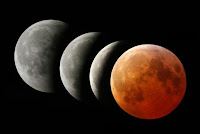The heavens are telling of the glory of God; And their expanse is declaring the work of His hands (Psalm 19:1 NAS)
 On December 20, 2010, The New York Times published a story about the lunar eclipse of the moon that was to take place the following day. According to the news story, the earth will prevent the sun’s rays from reaching the moon over the course of about 72 minutes. Such a lunar eclipse will not happen again until 2094. For the first time in 372 years, the lunar eclipse coincides with the winter solstice, the time at which the sun is at its southernmost point in the sky. The National Aeronautics and Space Administration (NASA) not wanting to let such a spectacle escape its gaze has set up several ways for sky watchers to view pictures and watch live video feed from a camera mounted at the Marshall Space Flight Center in Huntsville, Ala.
On December 20, 2010, The New York Times published a story about the lunar eclipse of the moon that was to take place the following day. According to the news story, the earth will prevent the sun’s rays from reaching the moon over the course of about 72 minutes. Such a lunar eclipse will not happen again until 2094. For the first time in 372 years, the lunar eclipse coincides with the winter solstice, the time at which the sun is at its southernmost point in the sky. The National Aeronautics and Space Administration (NASA) not wanting to let such a spectacle escape its gaze has set up several ways for sky watchers to view pictures and watch live video feed from a camera mounted at the Marshall Space Flight Center in Huntsville, Ala.A lunar eclipse can only occur when the sun, earth and moon are aligned exactly or at close proximity with earth in the middle. This is why it is always a full moon the night of a lunar eclipse. The length and the type of an eclipse depend on the moon's location, relative to its orbital nodes. A lunar eclipse normally lasts for more than an hour and may stretch on to several hours, whereas a total solar eclipse lasts only a few minutes at any given place. Unlike a solar eclipse which can only be viewed from a relatively small area of the world, a lunar eclipse can be viewed from anywhere on earth, so long as it is night. The lunar eclipse of December 21, 2010 was visible in its entirety in North and South America, Iceland, Ireland, Britain and northern Scandinavia.
Knowing how an eclipse occurs when the sun, earth and moon align according to the designed order of the One who is in control should amaze us. The psalmist says, "When I consider Your heavens, the work of Your fingers, The moon and the stars, which You have ordained; What is man that You take thought of him, And the son of man that You care for him?” (Psalm 8:3-4 NAS). The heavens tell of the glory of God, and the skies declare His handiwork (Psalm 19:1). Our God is able to make the sun go down at noon and the earth dark in broad daylight (Amos 8:9). He is the One who made the moon for the seasons, and the sun knows the place of its setting (Psalm 104:19). The sun will not smite us by day, nor the moon by night, for the LORD will protect us from all evil and will keep our souls (Psalm 121:6-7). He is our keeper, our shade at our right hand (Psalm 121:5).
Let us therefore worship God and be awed by His creation and majesty, for the LORD has declared the heaven is His throne and the earth is His footstool, and by His hand all these things were made (Isaiah 66:1-2). Should we therefore not bow before Him and sing His praise in reverence and worship? Should we not, like NASA, find ways to ensure a spectacle such as God’s magnificent creation does not escape its gaze by helping the world see and experience live the goodness of God?
Rather than be like the sun, earth and moon which come together in alignment only once in a blue moon, let us as fellow believers in the Lord meet regularly to examine and align our understanding of God’s word (Hebrews 10:25; Acts 17:11). When sharing the gospel, let us be like the lunar eclipse to take time to reach people from anywhere on earth, instead of like the solar eclipse which quickly go away once a small area is covered. Just as the lunar eclipse is visible in its entirety where there is night, let us reveal the entirety of Christ to the world, where in the darkness is the Light that shines (John 1:5).
Dear Lord, in the immensity of the universe and Your creation, we cannot help but to praise and worship You. Shine therefore through us Lord that Your light may be revealed to the world. Put in our hearts the desire to meet with fellow believers regularly to examine and align our understanding of Your word. Help us Lord when sharing the gospel, not to rush but to spend time to reach the unsaved for You.
No comments:
Post a Comment